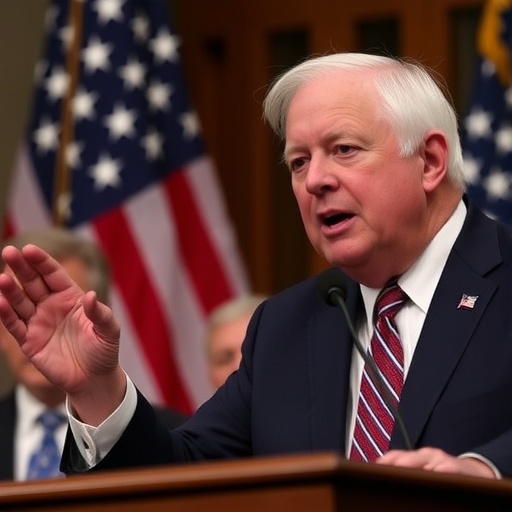Speaker Johnson Issues Dire Warning: Government shutdown Poised to Shatter Records Over Health Insurance Impasse
In a tense address on the House floor, Speaker Mike Johnson has sounded the alarm that the ongoing Government shutdown could etch itself into history books as the longest ever, surpassing the 35-day ordeal of 2018-2019. With negotiations frozen solid over Democratic insistence on shielding health insurance programs from deep cuts, both parties are bracing for a blame game that could ripple through the midterm elections and beyond. As federal workers go unpaid and essential services teeter, Johnson’s stark words underscore a deepening partisan chasm in Washington.
Johnson’s Floor Speech Ignites Shutdown Fears
Speaker Johnson’s remarks came during a heated session where he lambasted what he called “obstructionist tactics” from the Democrats. “This Government shutdown is not just a standoff; it’s a crisis of unprecedented magnitude,” Johnson declared, his voice echoing through the nearly empty chamber. He pointed to the clock, noting that the shutdown, now in its 28th day, has already outlasted several historical precedents, including the 21-day closure in 1995-1996 under President Clinton.
Behind the rhetoric lies a tangle of fiscal priorities. The current impasse stems from a sprawling spending bill that Republicans pushed through the House, aiming to trim billions from social programs, including health insurance subsidies under the Affordable Care Act (ACA). Democrats, led by Senate Minority Leader Chuck Schumer, have vowed to block any measure that undermines coverage for millions of low-income Americans. “We’re not budging on protections that keep families from financial ruin,” Schumer retorted in a post-speech briefing, highlighting the human stakes.
Historical data paints a grim picture. According to the Congressional Research Service, the average government shutdown lasts about 8 days, but this one threatens to balloon into something far worse. Economists at the Bipartisan Policy Center estimate daily costs at $1.2 billion, factoring in lost productivity and delayed payments to 2.1 million federal employees. Johnson’s warning isn’t hyperbole; with no breakthrough in sight, projections suggest the shutdown could hit 40 days by mid-December, eclipsing the 2018 record and potentially costing the economy up to $50 billion.
Democrats’ Health Insurance Demands Stall Key Negotiations
At the heart of the stalemate are Democratic demands to roll back proposed health insurance cuts embedded in the Republican-backed bill. The legislation, dubbed the “Fiscal Responsibility Act,” seeks to slash $300 billion from Medicaid expansions and ACA marketplace subsidies over the next decade. Proponents argue it’s essential for deficit reduction, but critics, including a coalition of 150 Democratic lawmakers, warn it could strip coverage from 15 million Americans, per estimates from the Kaiser Family Foundation.
Negotiations have been a whirlwind of closed-door meetings and public posturing. House Democrats, in a letter signed by Minority Leader Hakeem Jeffries, outlined three non-negotiable points: preserving ACA funding, expanding mental health parity in insurance plans, and auditing Medicare for waste without touching beneficiary benefits. “Health care isn’t a bargaining chip,” Jeffries stated during a press conference outside the Capitol, flanked by nurses and patient advocates. The group cited a recent Gallup poll showing 62% of voters oppose any health insurance reductions, a sentiment that’s pressuring Democrats to hold firm.
Yet, the Democrats‘ strategy isn’t without risks. Internal GOP memos, leaked to Politico, reveal frustration among moderate Republicans who fear voter backlash in swing districts. One such lawmaker, Rep. Brian Fitzpatrick (R-PA), broke ranks to co-sponsor a bipartisan amendment that would cap health insurance cuts at 10%, but it was swiftly tabled by leadership. As negotiations drag on, procedural votes in the Senate have repeatedly failed, with filibuster threats from both sides ensuring gridlock.
To illustrate the breadth of the dispute, consider the affected programs:
- Medicaid: Proposed 20% funding cut, impacting 80 million enrollees, including children and the elderly.
- ACA Subsidies: $150 billion reduction, potentially raising premiums by 25% for middle-class families.
- CHIP: Children’s Health Insurance Program faces a $40 billion shortfall, threatening coverage for 9 million kids.
These details, drawn from the bill’s 1,200-page text, have fueled protests outside federal buildings, where furloughed workers and health advocates chant for resolution.
Public Backlash Mounts as Both Parties Face Blame
The government shutdown‘s toll is mounting, and public opinion is turning sour on all fronts. A fresh Quinnipiac University poll reveals that 55% of Americans blame Republicans for the impasse, up from 48% last week, while 42% point fingers at Democrats. Speaker Johnson’s approval rating has dipped to 34%, according to the same survey, as constituents in his Louisiana district report delays in Social Security checks and national park closures.
Stories of hardship are emerging nationwide. In Atlanta, federal air traffic controllers, working without pay, have shared tales of dipping into savings to cover mortgages. “I’ve got two kids and a wife relying on my paycheck—this shutdown is breaking us,” one anonymous controller told CNN. Similarly, in rural Ohio, a community health center warned of impending closures due to frozen health insurance reimbursements, leaving 5,000 patients in limbo.
Speaker Johnson attempted to shift the narrative in a Fox News interview, accusing Democrats of “playing politics with people’s lives” by prioritizing health insurance over border security funding. But the retort was swift: White House Press Secretary Karine Jean-Pierre countered that the administration stands ready for negotiations, provided Republicans drop “extreme demands.” Bipartisan groups like No Labels have called for a “shutdown truce,” proposing a short-term funding bill to buy time, but it garnered only 120 co-sponsors in the House.
Economically, the shutdown’s shadow looms large. The U.S. Chamber of Commerce reported a 0.2% GDP hit in the first two weeks alone, with small businesses suffering from delayed contracts. Stock markets have wobbled, with the Dow dropping 1.5% on the day of Johnson’s speech, as investors fret over prolonged uncertainty. Veterans’ groups, hit hard by VA service disruptions, have launched a “Pay Our Patriots” campaign, amassing 200,000 signatures urging Congress to act.
Historical Echoes: How This Shutdown Compares to Past Crises
To grasp the gravity, it’s worth revisiting shutdown history. The 2018-2019 event, the longest until now, stemmed from immigration disputes and cost $11 billion. Speaker Johnson’s current warning evokes that era, but with a twist: this time, health insurance is the flashpoint, not walls or DACA. In 1995, Newt Gingrich’s standoff over Medicare reforms lasted 21 days, leading to his eventual ouster. Analysts at the Brookings Institution draw parallels, suggesting Johnson risks a similar fate if the government shutdown persists.
Key differences abound. Unlike past crises, social media amplifies the chaos—#ShutdownShame has trended with over 500,000 posts, featuring videos of closed IRS offices and hungry zoo animals in national parks. Negotiations today involve more stakeholders, including tech giants lobbying for cyber funding and pharma companies decrying health insurance instability. A report from the Government Accountability Office (GAO) details 47 agencies affected, from the FDA delaying drug approvals to the EPA halting environmental inspections.
Democrats’ leverage comes from Senate control, where a simple majority can block bills. Yet, cracks show: Sen. Kyrsten Sinema (I-AZ), once a Democrat, has signaled openness to compromise on health insurance tweaks if paired with infrastructure wins. Republicans, meanwhile, tout internal unity, with only three defections in recent whip counts. As Speaker Johnson navigates this minefield, whispers of a leadership challenge grow louder among Freedom Caucus members frustrated by the optics.
Statistics underscore the urgency:
- Over 800,000 federal workers furloughed, per OMB data.
- National parks visited by 325 million annually now shuttered, costing $76 million daily in lost revenue.
- Health insurance claims processing halted, delaying $2 billion in payments weekly.
These figures, compiled by nonpartisan watchdogs, paint a portrait of dysfunction that could define the 118th Congress.
Path Forward: Bipartisan Breakthroughs and Looming Deadlines
As the government shutdown barrels toward infamy, glimmers of hope flicker in unexpected places. Backchannel negotiations between moderate senators from both parties have yielded a framework: a 60-day funding extension that preserves core health insurance programs while kicking deeper cuts to a January conference committee. Speaker Johnson, in a rare nod to flexibility, hinted at supporting such a deal during a closed GOP meeting, provided it includes debt ceiling hikes.
Yet, deadlines loom. Treasury Secretary Janet Yellen warned that without action, the U.S. risks default by December 15, when extraordinary measures run dry. International allies, from the EU to Japan, have expressed concern over market volatility, with the IMF projecting a 0.5% global growth drag if the shutdown exceeds 40 days. Domestically, advocacy groups like AARP are mobilizing seniors, who rely heavily on Medicare, to flood congressional offices with calls.
Looking ahead, the implications are profound. A prolonged crisis could erode trust in institutions, boosting third-party appeals in 2024 races. If Democrats prevail on health insurance, it might embolden progressive pushes for Medicare-for-All. Conversely, Republican victories could pave the way for broader entitlement reforms. Speaker Johnson’s next move—scheduling a full House vote on a compromise bill—will be pivotal. As one Capitol Hill veteran put it, “This isn’t just about budgets; it’s about who controls the narrative of governance in America.” With holidays approaching and families strained, the pressure to end the government shutdown has never been higher, promising a resolution that could reshape Washington’s power dynamics for years to come.










